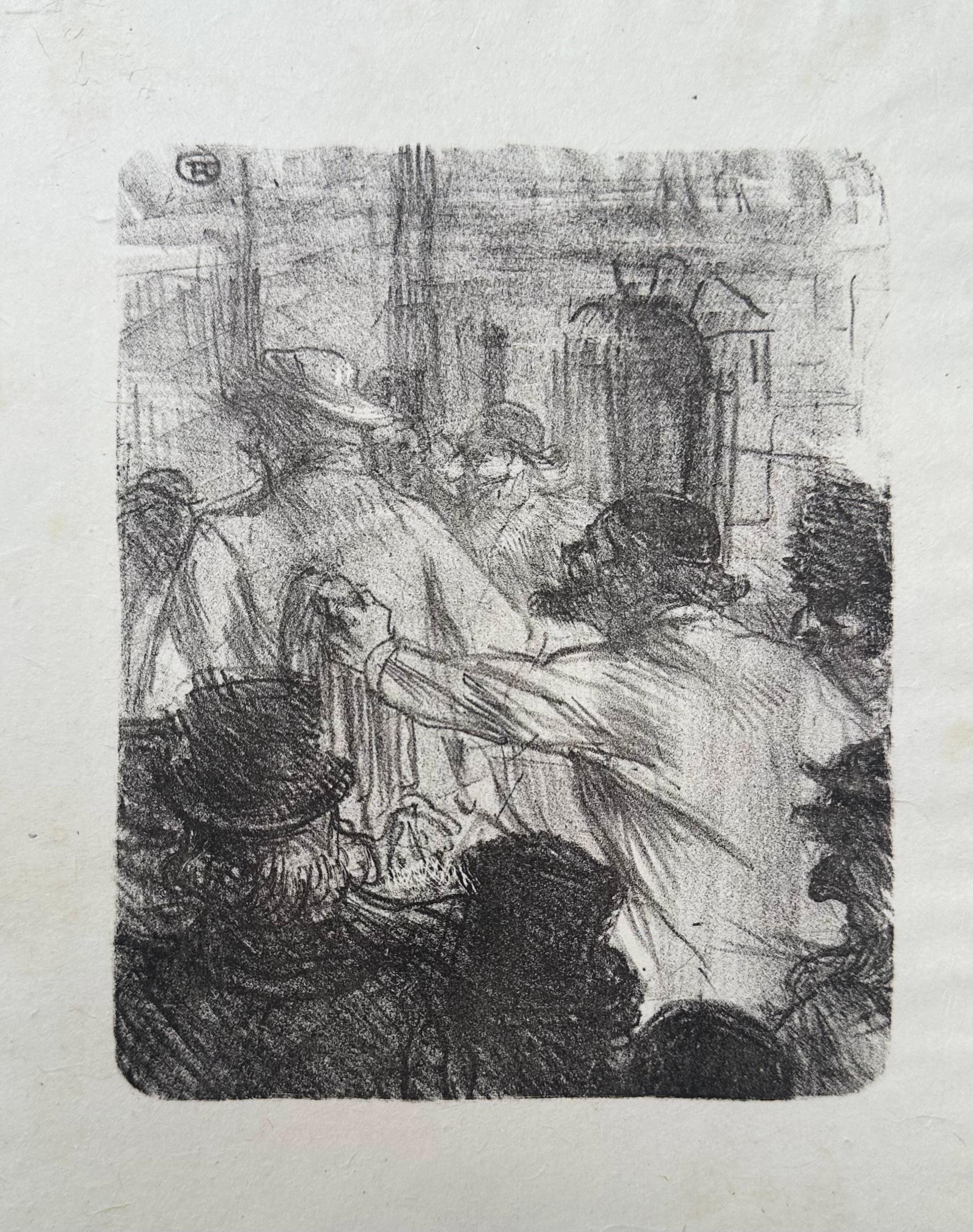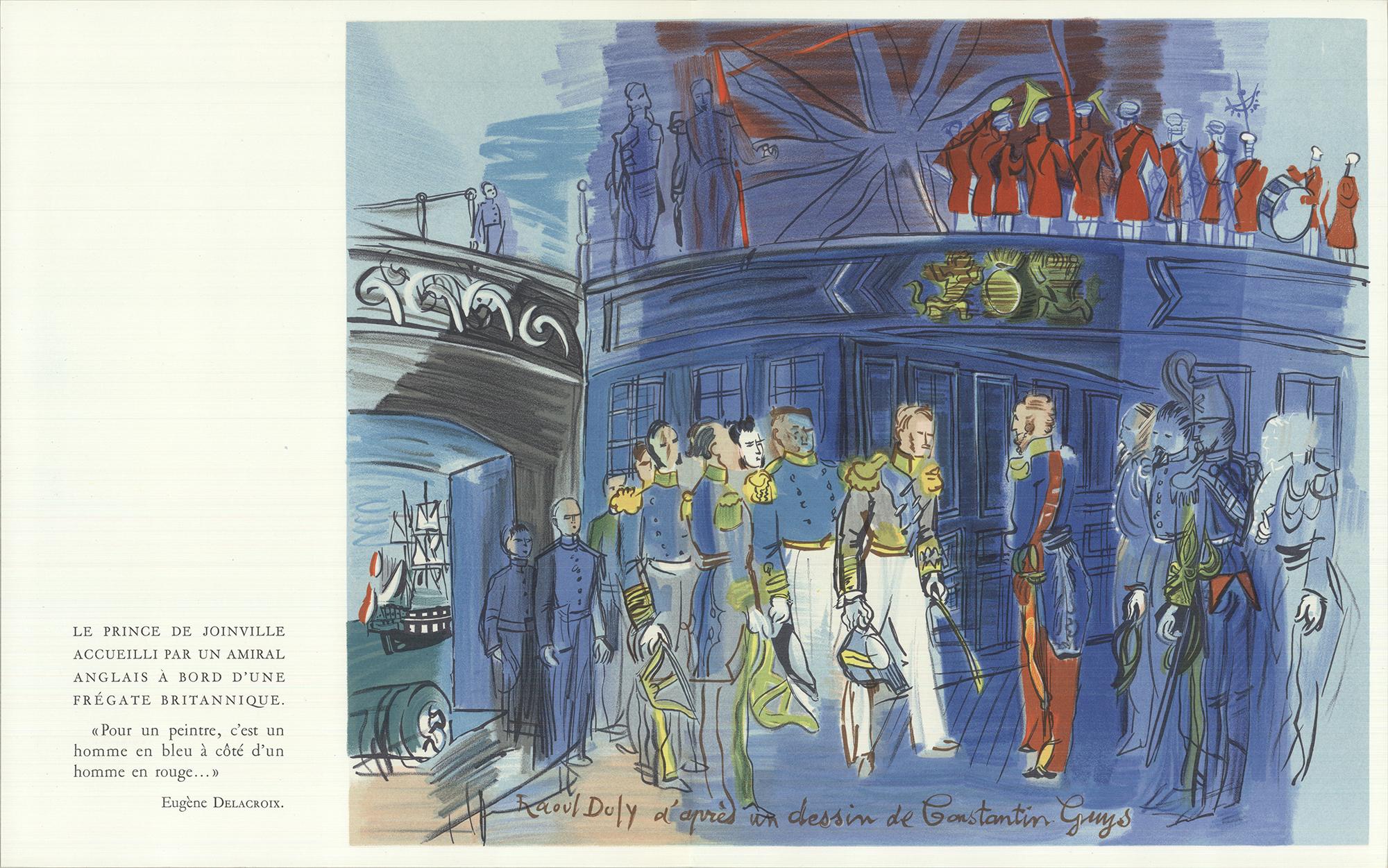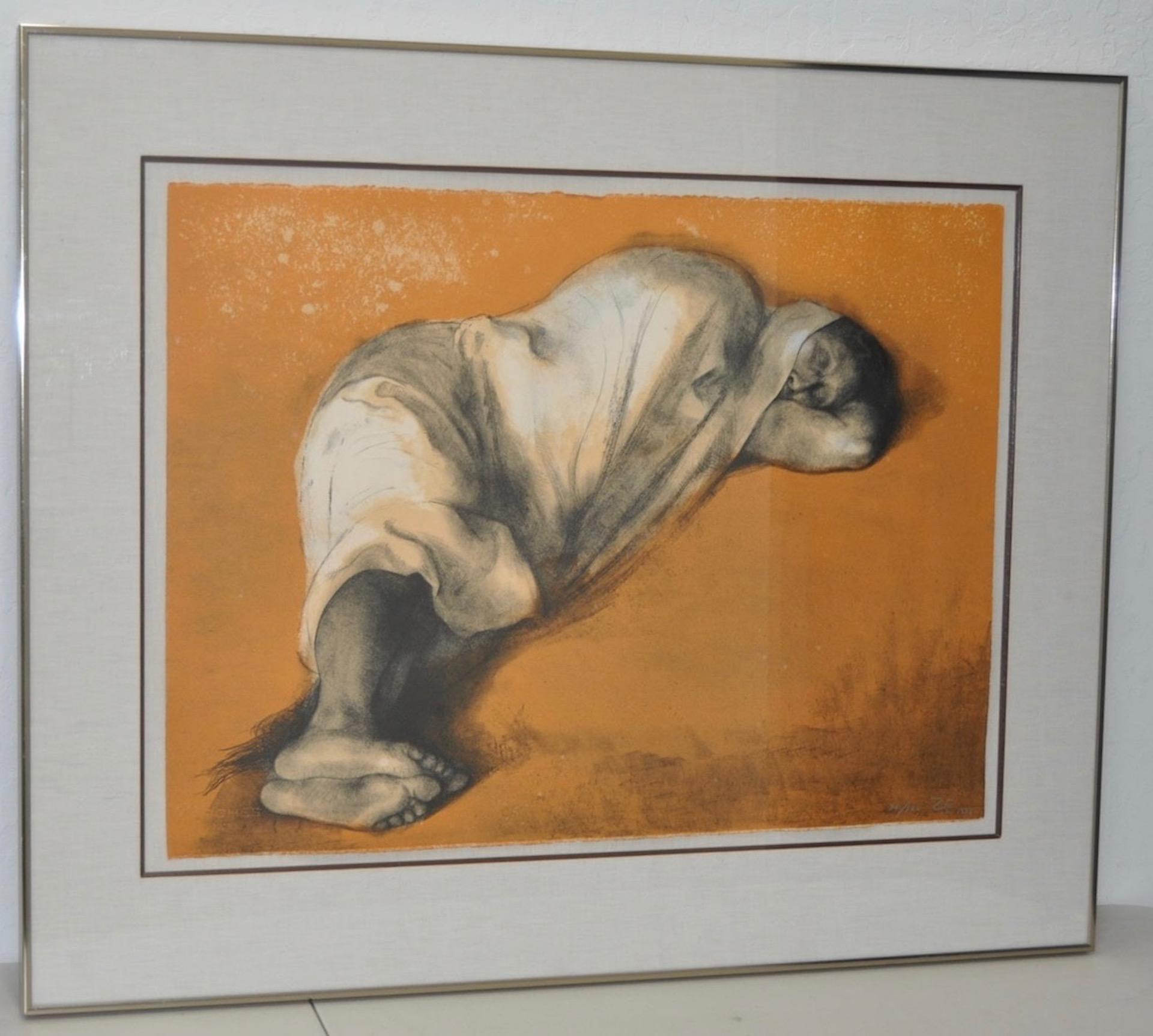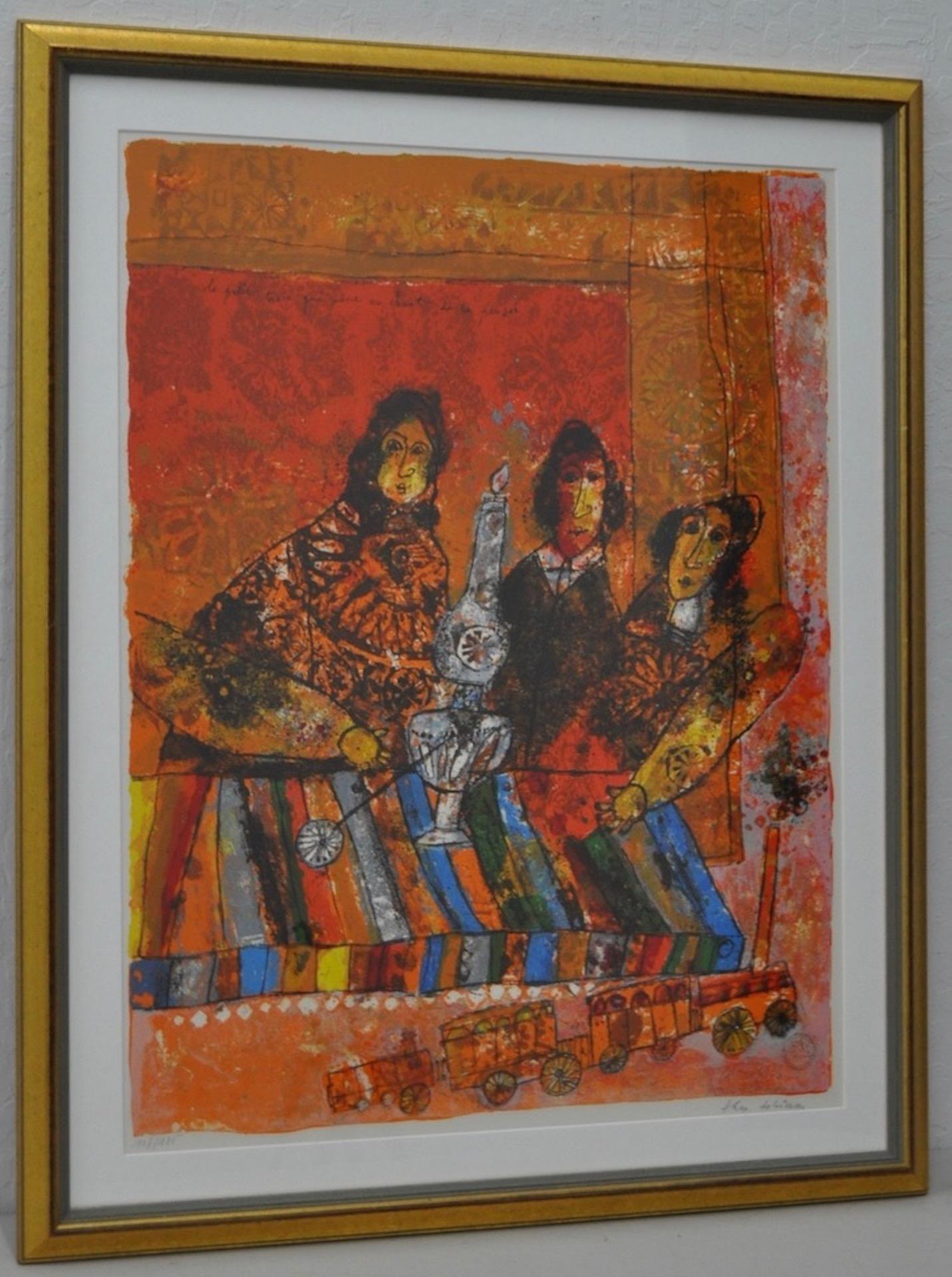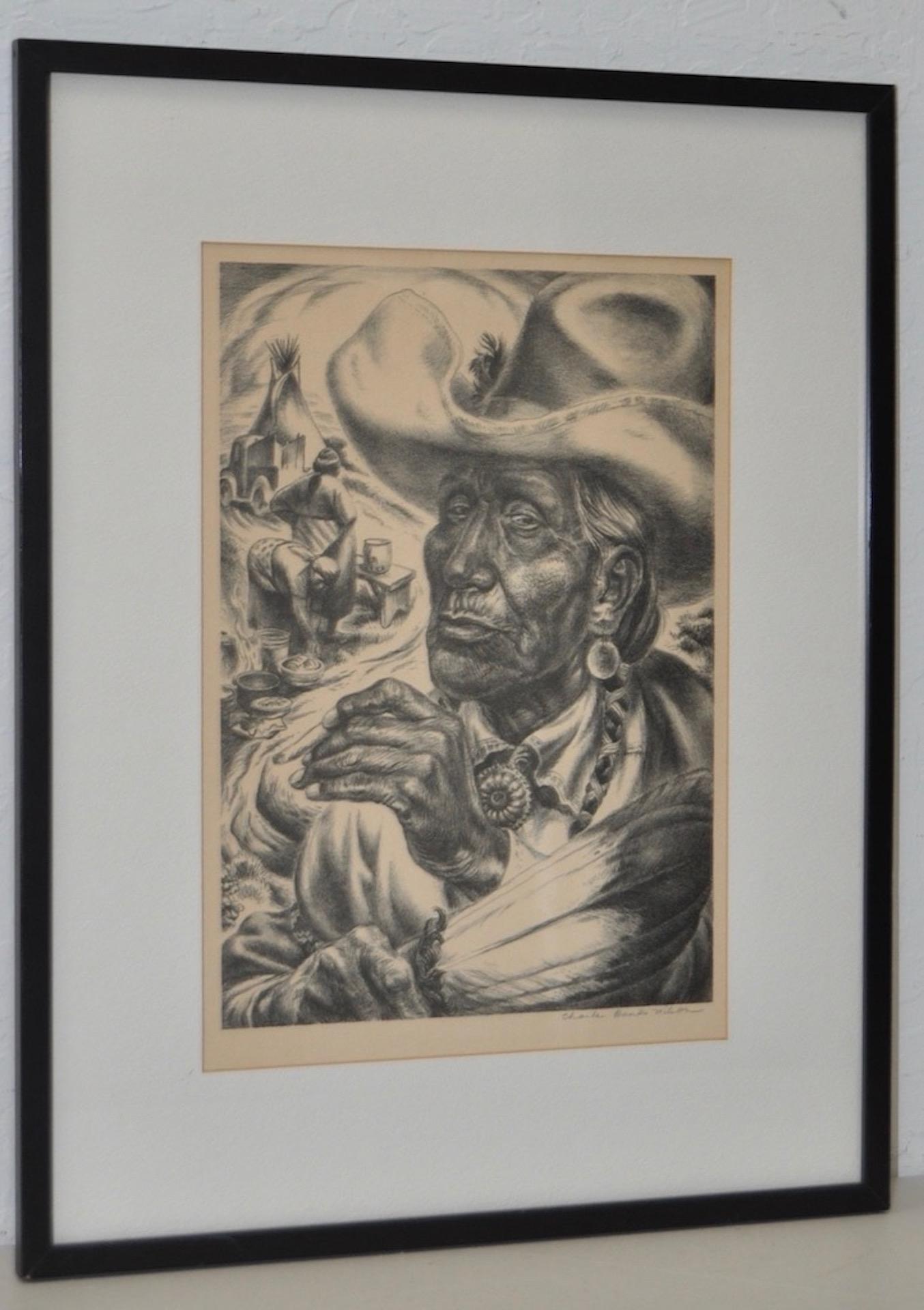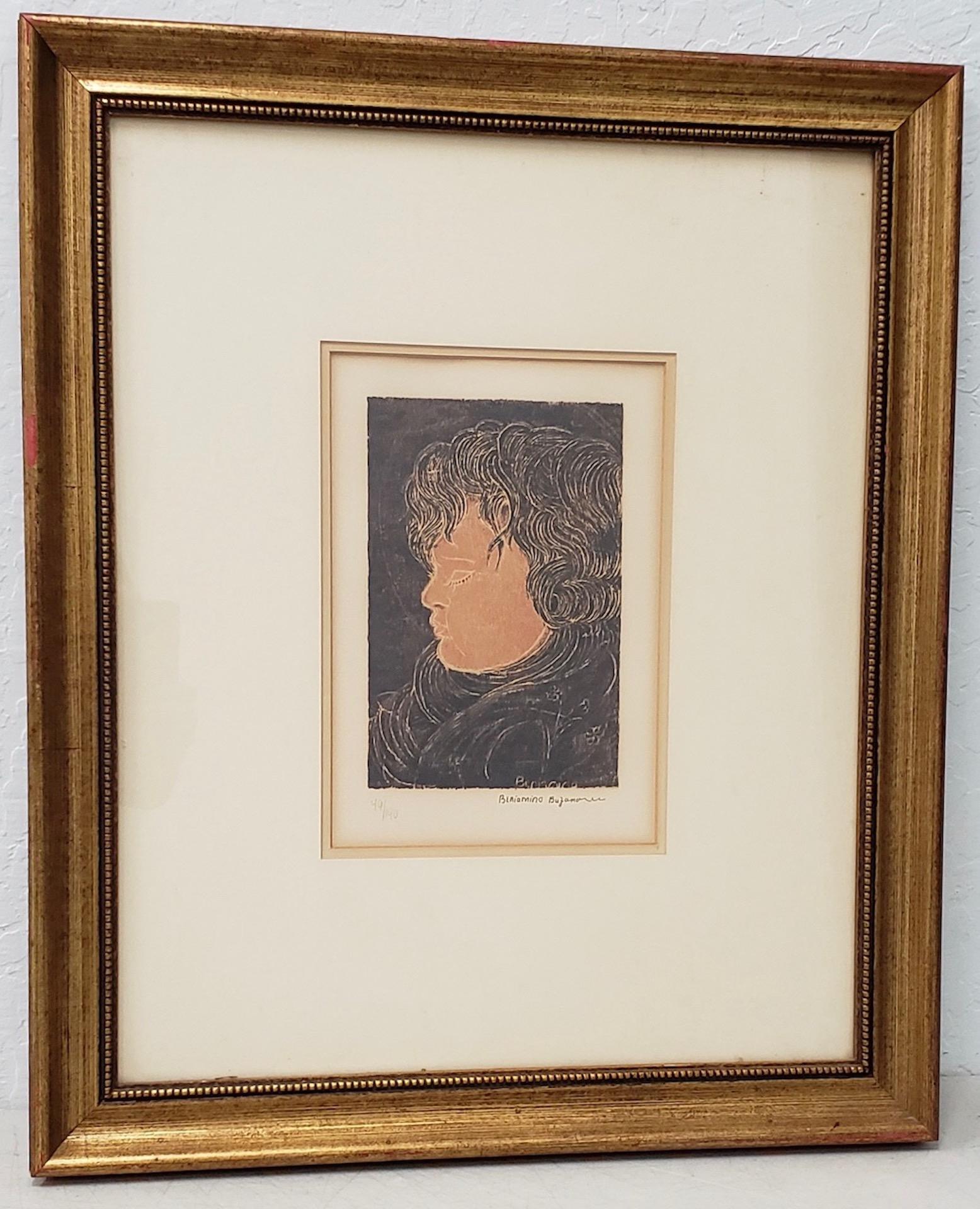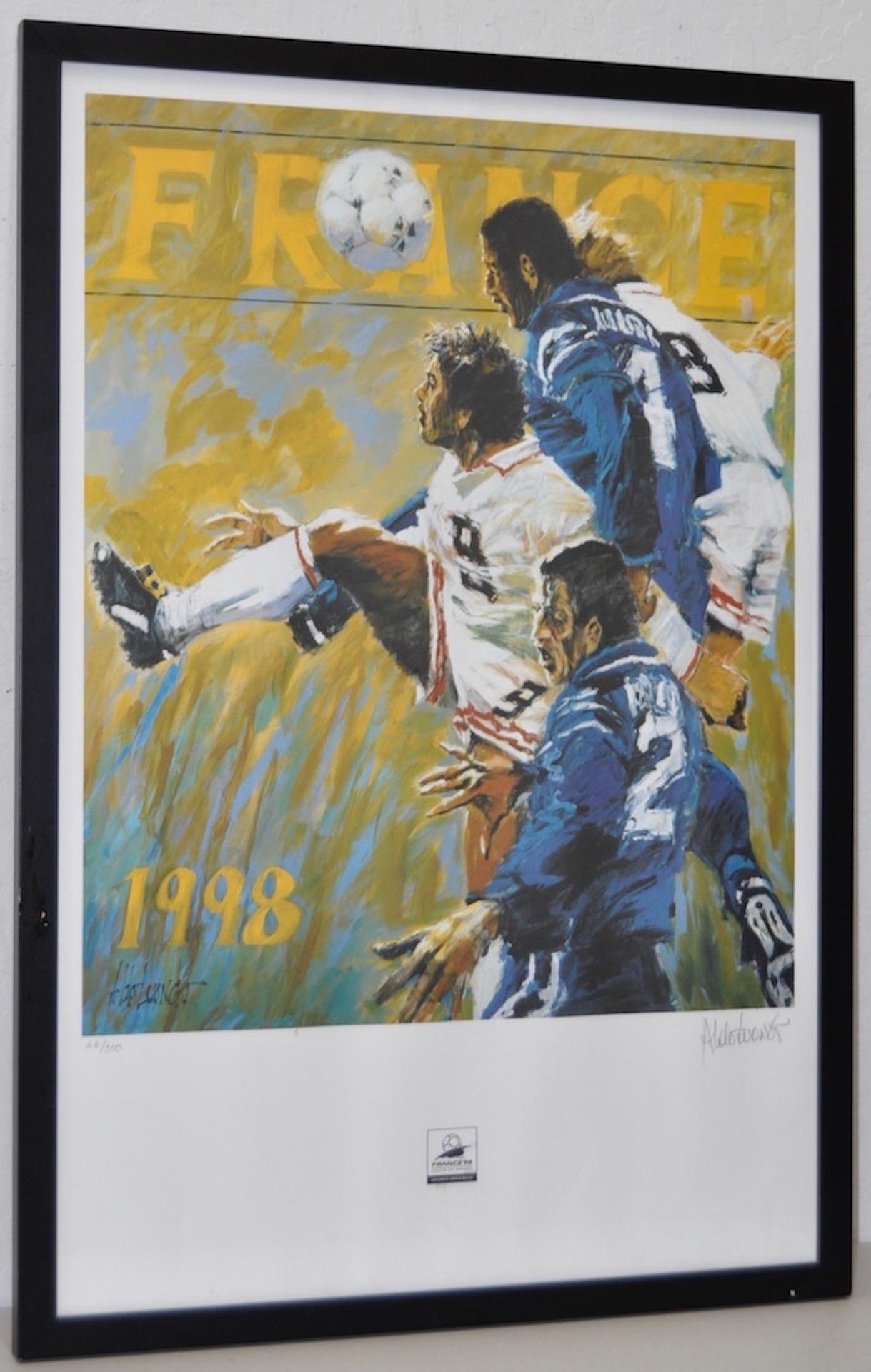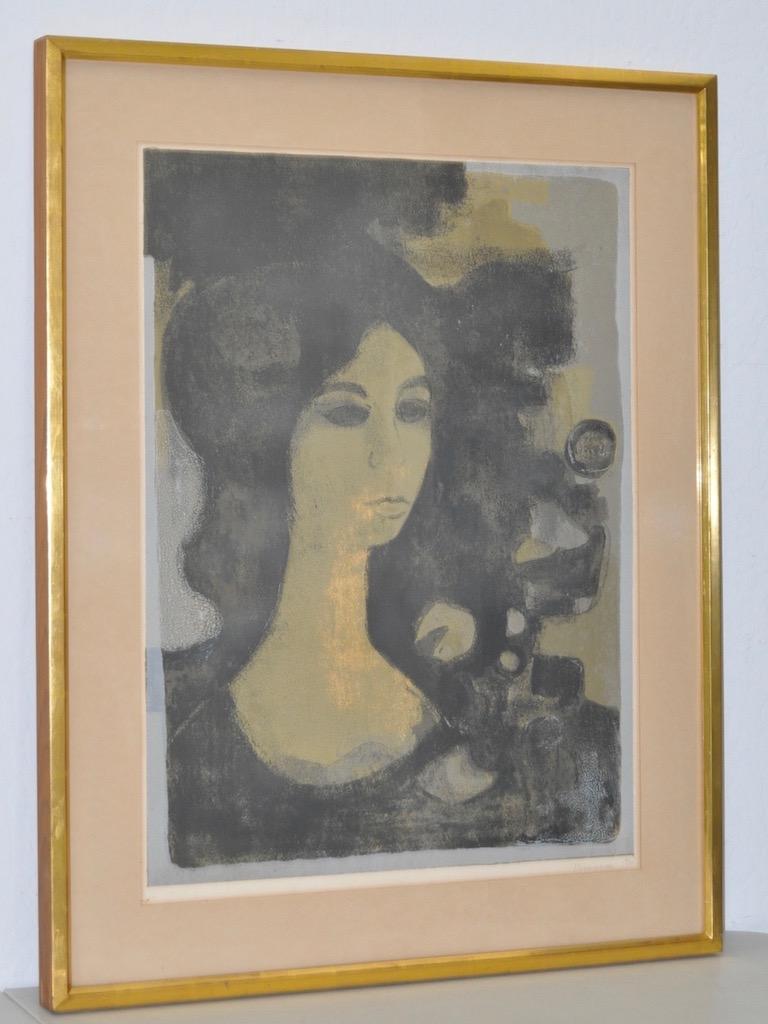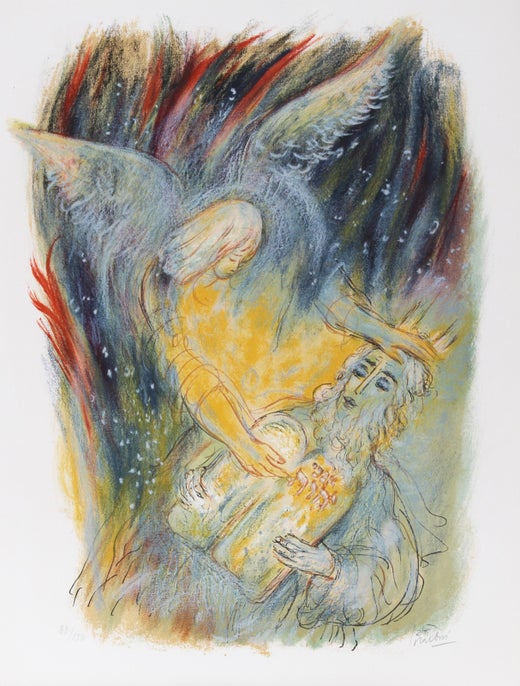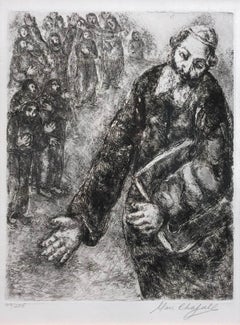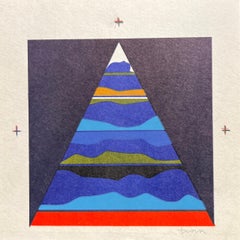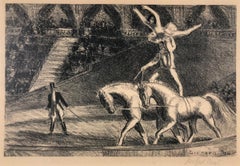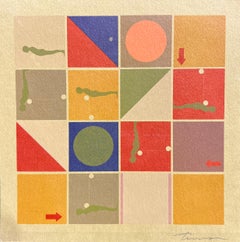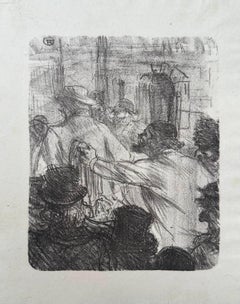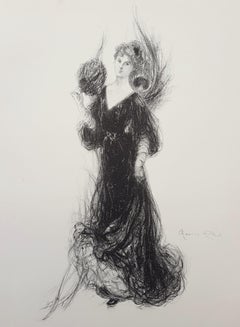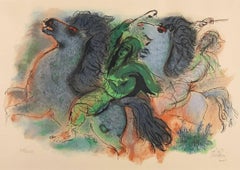
Horsemen in the Negev
View Similar Items
Want more images or videos?
Request additional images or videos from the seller
1 of 6
Reuven RubinHorsemen in the Negevc. 1970
c. 1970
Price:$1,500
About the Item
- Creator:Reuven Rubin (1893 - 1974, Israeli)
- Creation Year:c. 1970
- Dimensions:Height: 23.5 in (59.69 cm)Width: 29.25 in (74.3 cm)
- Medium:
- Movement & Style:
- Period:
- Condition:
- Gallery Location:Missouri, MO
- Reference Number:1stDibs: LU74732773501
Reuven Rubin
Reuven Rubin- (November 13, 1893 - October 13, 1974) was a Romanian-born Israeli painter and Israel's first ambassador to Romania. Rubin Zelicovici (later Reuven Rubin) was born in Galaţi to a poor Romanian Jewish Hasidic family. He was the eighth of 13 children. In 1912, he left for Ottoman-ruled Palestine to study art at Bezalel Academy of Art and Design in Jerusalem. Finding himself at odds with the artistic views of the Academy's teachers, he left for Paris, France, in 1913 to pursue his studies at the École Nationale Supérieure des Beaux-Arts. At the outbreak of World War I, he was returned to Romania, where he spent the war years.
In 1921, he traveled to the United States with his friend and fellow artist, Arthur Kolnik, with whom he had shared a studio in Cernăuţi. In New York City, the two met artist Alfred Stieglitz, who was instrumental in organizing their first American show at the Anderson Gallery. Following the exhibition, in 1922, they both returned to Europe. In 1923, Rubin emigrated to Mandate Palestine.
Rubin met his wife, Esther, in 1928, aboard a passenger ship to Palestine on his return from a show in New York. She was a Bronx girl who had won a trip to Palestine in a Young Judea competition. He died in 1974.
About the Seller
5.0
Vetted Professional Seller
Every seller passes strict standards for authenticity and reliability
Established in 1970
1stDibs seller since 2017
155 sales on 1stDibs
Typical response time: 14 hours
Authenticity Guarantee
In the unlikely event there’s an issue with an item’s authenticity, contact us within 1 year for a full refund. DetailsMoney-Back Guarantee
If your item is not as described, is damaged in transit, or does not arrive, contact us within 7 days for a full refund. Details24-Hour Cancellation
You have a 24-hour grace period in which to reconsider your purchase, with no questions asked.Vetted Professional Sellers
Our world-class sellers must adhere to strict standards for service and quality, maintaining the integrity of our listings.Price-Match Guarantee
If you find that a seller listed the same item for a lower price elsewhere, we’ll match it.Trusted Global Delivery
Our best-in-class carrier network provides specialized shipping options worldwide, including custom delivery.More From This Seller
View AllJoshua Reads the Word of the Law (Pencil Signed)
By (after) Marc Chagall
Located in Missouri, MO
Signed in Pencil Lower Right "Marc Chagall"
Numbered Lower Left 77/275
Image Size: approx. 11 3/4 x 9 1/4 inches
Framed Size: approx. 24 x 21 inches
Category
1950s Impressionist Figurative Prints
Materials
Lithograph
Study/Falling Man (Series II)
By Ernest Tino Trova
Located in Missouri, MO
Study/Falling Man (Series II), 1967
By. Ernest Tino Trova (American, 1927-2009)
Signed in Pencil Lower Right
Color Lithograph
Unframed: 6 x 6 inches
With Frame: 8.75 x 8.5 inches
Kn...
Category
20th Century American Modern Abstract Prints
Materials
Lithograph
Price Upon Request
Bareback Act, Old Hippodrome
By Gifford Beal
Located in Missouri, MO
Bareback Act, Old Hippodrome
By Gifford Beal (1879-1956)
Signed Lower Right
Unframed: 6.5" x 9.5"
Framed: 17.5" x 20"
Gifford Beal, painter, etcher, muralist, and teacher, was born in New York City in 1879. The son of landscape painter William Reynolds Beal, Gifford Beal began studying at William Merritt Chase's Shinnecock School of Art (the first established school of plein air painting in America) at the age of thirteen, when he accompanied his older brother, Reynolds, to summer classes. He remained a pupil of Chase's for ten years also studying with him in New York City at the artist's private studio in the Tenth Street Studio Building. Later at his father's behest, he attended Princeton University from 1896 to 1900 while still continuing his lessons with Chase. Upon graduation from Princeton he took classes at the Art Students' League, studying with impressionist landscape painter Henry Ward Ranger and Boston academic painter Frank Vincent DuMond. He ended up as President of the Art Students League for fourteen years, "a distinction unsurpassed by any other artist."
His student days were spent entirely in this country. "Given the opportunity to visit Paris en route to England in 1908, he chose to avoid it" he stated, "I didn't trust myself with the delightful life in ParisIt all sounded so fascinating and easy and loose." His subjects were predominately American, and it has been said stylistically "his art is completely American." Gifford achieved early recognition in the New York Art World.
He became an associate member of the National Academy of Design in 1908 and was elected to full status of academician in 1914. He was known for garden parties, circuses, landscapes, streets, coasts, flowers and marines. This diversity in subject matter created "no typical or characteristic style to his work."
Beal's style was highly influenced by Chase and Childe Hassam, a long time friend of the Beal family who used to travel "about the countryside with Beal in a car sketching...
Category
20th Century American Modern Animal Prints
Materials
Lithograph
Price Upon Request
Study/Falling Man (Series I)
By Ernest Tino Trova
Located in Missouri, MO
Study/Falling Man (Series I), 1967
By. Ernest Tino Trova (American, 1927-2009)
Black Frame, Green Background
Signed in Pencil Lower Right
Unframed: 6 x 6 inches
With Frame: 8.75 x 8....
Category
20th Century American Modern Abstract Prints
Materials
Lithograph
Price Upon Request
The Hymn Singer
By Thomas Hart Benton
Located in Missouri, MO
Signed in Pencil Lower Right
Ed. 500
Circulated by Twayne Publishers, New York City
Image Size: 16 x 12 3/8
Framed Size: 24 1/4 x 20 1/2 inches
The legendary actor actor and musici...
Category
1950s American Realist Portrait Prints
Materials
Lithograph
Price Upon Request
Madame Butterfly
By Larry Rivers
Located in Missouri, MO
Lithograph and silkscreen, 1978
23 x 31 inches (image and sheet)
28 x 36 framed
Signed, dated and numbered ed. 300 lower left
Printed by Styria Studios
Figurative* artist Larry Rive...
Category
1970s Pop Art Figurative Prints
Materials
Lithograph
Price Upon Request
You May Also Like
MARC CHAGALL "Le joueur de flûte"
By Marc Chagall
Located in Los Angeles, CA
MARC CHAGALL 1887 - 1985
"Le joueur de flûte"
1958
Colour lithograph
25.5x44 cm, illustration; 38.3x57.3 cm, sheet size
Signed lower right by the artist in ink "Marc Chagall" and dedicated "Pour Ursula et Gerd Hatje / "merci" / Marc Chagall / 1958". Inscribed lower left by the artist "Epreuve d'artiste".
This is an artist’s proof, aside from the edition of 90.
Catalogue Raisonné : Mourlot 197
Gerd Hatje (14 April 1915 – 24 July 2007) was a German publisher. The publishing house that he founded in 1945, named the Humanitas Verlag, renamed in 1947 as Verlag Gerd Hatje, is internationally known for contemporary art, photography and architecture. It merged in to Hatje Cantz in 1999. In the 1950s and 1960s, Hatje changed the focus to art, photography, and architecture.[1] He had contact with and was a friend of contemporary artists such as Hans Arp, Willi Baumeister, Joseph Beuys, Max Bill, Georges Braque, Marcel Breuer, Marc Chagall, Christo, Le Corbusier, Max Ernst, Alberto Giacometti, Walter Gropius, Joan Miró, Pablo Picasso, Ludwig Mies van der Rohe, and James Stirling...
Category
Mid-19th Century Impressionist Figurative Prints
Materials
Paper, Lithograph
Bomber and Buckeroos by Till Goodan, Westward Ho Company
Located in Phoenix, AZ
Bomber And Buckeroos ca. 1939
Till Goodan
Offset Lithograph
PRINTS ARE IN GOOD CONDITION. PRINTS MAY HAVE SMALL FLAW ALONG EDGE OF PAPER, DOES NOT EFFECT THE PRINT IMAGE
All the prints are 26 x 31 inches, Mustang Peeler, Bombers and Buckaroos, The stranger, Guardians of the Range and Range Baby.
Note that “The Mustang Runner” is 3 inches shorter in height, 23 x 31 inches
The print by Till Goodan was originally a painting and reproduced by the Westward Ho company as a set. Westward Ho produced the most sought after Western dinnerware ever made. The most popular pattern was the Rodeo pattern by Till Goodan. He Illustrated and branded many accessories sold by the Westward Ho Company.
Tillman Parker Goodan 1896-1958
To the casual observer his paintings are exciting and colorful. To the scholars of the Western Era they are benchmarks of authenticity. Such is the style of Till Goodan. He was born Tillman Parker Goodan in Eaton, Colorado on March 27, 1896. His father was a true western pioneer, mayor of Eaton, publisher of its first newspaper, and County Commissioner for several years.
After moving to California in 1905 and settling on a little farm that bordered the Michel Cattle Ranch, Till spent much of his boyhood with the Michel sons working on their ranch. There he developed his expertise as a calf roper and the skills of a working cowboy.
As a young man Till pursued endeavors that would initially callous his emerging artistic hands. He worked for the famous Miller and Lux Ranch in California. He packed mules and ran pack trains into the Sierra Mountains. He broke horses and competed in local rodeos riding saddle broncs and roping calves. And during the quiet hours he would draw pictures of ranch life and the action of the rodeo. People began commenting on his talents as an artist.
In 1917 he left the rodeo circuit and turned his full attention to a career in art. He studied with Roger Sterrett, William Paxton, and Dana Bartlett, all highly respected California artists. Till soon became a free-lance commercial artist doing work for Grauman’s Chinese and Lowe’s Theaters, Helms Bakery and Security Bank. He later assumed a position as Art Director for the Richfield Oil Company. However, his first love was still the art of the old west, horses, cowboys, and ranching. So, he left Richfield and gave his full attention to the field of fine arts.
He did oil painting, water colors and lithographs. He drew the Gene Autry Comic Books. He illustrated and hand lettered a large collection of stories about famous bucking horses, ranches, horsemen of the world, and western gear. In association with W.C. Wentz, he started producing a complete line of western gift wares, ceramics, bronzes, leather, paper, and fabric.
By the 1930′s he was beginning to receive recognition for his western art and by the early 1940s, he and his daughter, Betty, were illustrating comic books for his longtime friend, Gene Autry. Betty was also a world champion cowgirl.
Till Goodan designs appeared in virtually every medium. But, the most famous was the four lines of dinnerware produced by Wallace China...
Category
1930s American Impressionist Figurative Prints
Materials
Lithograph
Henri de Toulouse-Lautrec, La halle aux draps, Cracovie, 1898
By Henri de Toulouse-Lautrec
Located in Torino, IT
HENRI DE TOULOUSE LAUTREC, Albi 1864 - Malromé 1901
La halle aux draps, Cracovie, 1898
Original lithograph on stone monogrammed in plate (mm 176x144) Bibliography: Wittrock 197
Fro...
Category
1890s Impressionist Figurative Prints
Materials
Lithograph
Parisienne /// Art Nouveau French Lithograph Impressionist Figurative Lady Woman
By Maurice Eliot
Located in Saint Augustine, FL
Artist: Maurice Eliot (French, 1862-1945)
Title: "Parisienne"
Portfolio: Revue de l'Art Ancien & Moderne
*Issued unsigned, though signed by Eliot in the plate (printed signature) low...
Category
Early 1900s Impressionist Figurative Prints
Materials
Lithograph
Behind the door. 4/10., paper, lithography, 55x70 cm
Located in Riga, LV
Semjon Segelman (1933)
Category
Late 20th Century Impressionist Figurative Prints
Materials
Paper, Lithograph
Le Prince de Joinville recu a bord d'une fregate anglaise
By Raoul Dufy
Located in Brooklyn, NY
This lithograph titled Le Prince de Joinville reçu à bord d'une frégate anglaise is part of the book Lettre à mon Peintre by Marcelle Oury. The lithograph is printed on high-quality ...
Category
1960s Impressionist Figurative Prints
Materials
Lithograph
$100 Sale Price
20% Off

